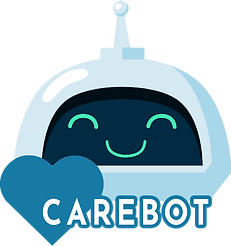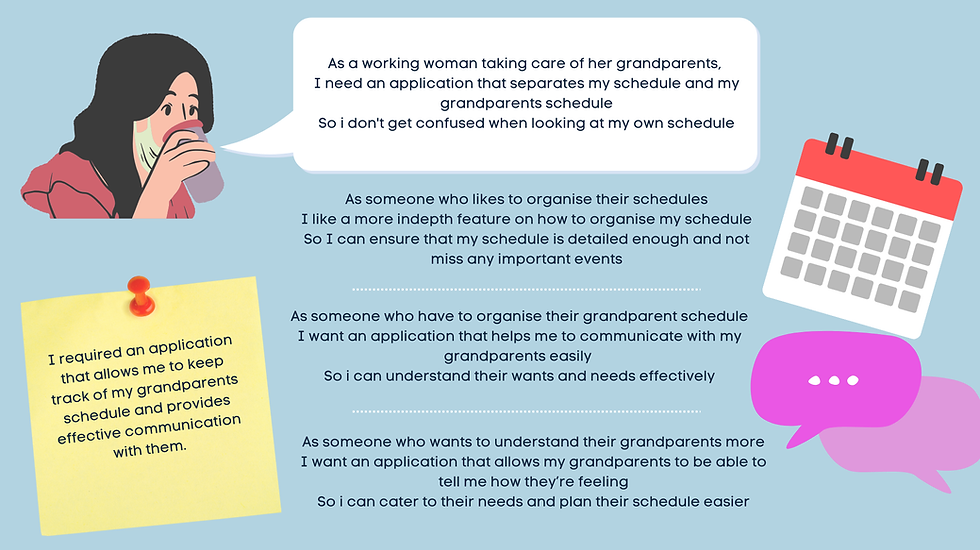STUDENT PROJECT
CAREBOT

INTRODUCTION
CareBot is an application to help people care for patients, specifically elderly, with dementia. It is a one stop platform where users can store their patients information, close friends and families photos and many more. By using CareBot, users will have an easier time caring for their patients.
Carebot is a solo project that is developed over the span of one week.
DESIGN APPROACH
Carebot was developed using the design thinking process. Design thinking is a human-centered approach involving empathize, define, ideate, prototype, and test stages. It focuses on understanding user needs and iterating solutions for optimal functionality.





Emphathize
Define
Ideate
Prototype
Test
EMPHATHIZE AND DEFINE
To kickstart this project, I conducted research and gathered data on patients with dementia. This helped me understand the problems they face and allowed me to design Carebot features tailored to their caretakers needs.
What is Dementia?
Dementia is the loss of cognitive functioning — thinking, remembering, and reasoning. It is more common as people grow older (about one-third of all people age 85 or older may have some form of dementia).
Symptoms of Dementia
Memory Loss
Difficulty in Speaking and Communicating
Hallucinating or Experiencing Delusions or Paranoia
USER PERSONAS AND REQUIREMENTS
To better ideate the features for Carebot, I came up with three user personas according to Carebot's targeted audience.

_.png)
Mun Shuen, a project coordinator, needs an application that helps separate her and her grandparents' schedules, offers detailed organization features, and facilitates effective communication to understand and cater to her grandparents' needs.


Jesper Tay needs an application to store familiar faces for his grandmother, with descriptions of who they are, to help her recognize him and feel secure. He requires easy access to this feature for effective care and communication.


Andrew Clark needs an application to store and manage multiple patients' medical records, ensuring easy navigation and access. He requires a tool that helps track patients' health daily and supports the storage of familiar faces for patient recognition.
IDEATE
Based on the user personas that I've developed for Carebot, , I developed four features to aid in their care according to the patients' symptoms.

Patient's Record
CareBot offers a platform to store all the patient's important information such as their name, NRIC number, emergency contacts etc.

Facial Recognition for Familiar Faces
CareBot offers a feature where users can upload photo's of familiar faces that patients sees everyday as a way for them to help with their memory.

Communication Feature
CareBot offers a feature where patients can communicate with their caregiver using simple emojis and icons.
Patient's Schedule Management

CareBot offers a calendar and a to do list for caretakers to manage their patient's schedule.
USER JOURNEY
Based on the features, I developed the user journey for how the user personas will interact with Carebot. This ensures a smooth experience in meeting their needs while using the app.

This user flow shows Mun Shuen adding an event. She starts at the Schedule Page and checks if the event is on the 27th of December 2022. If yes, she taps "Add Event." If no, she taps "Calendar" and selects the correct date. Then, she taps "Add Event" and fills in the required information.

This user flow shows how Jesper Tay adds a photo for his grandmother in Carebot. He starts at the main screen and selects the "Add Photo" option. He then uploads or selects a photo from the gallery. Jesper fills in details about the person in the photo, including their name and relationship to his grandmother. Finally, he saves the information, making it easily accessible for his grandmother to recognize familiar faces.

This user flow shows how Andrew Clark checks his patient's information in Carebot. He starts by tapping on "Add Patient." If the patient is already added, he taps on the patient's ID. If not, he taps "Add Patient" and fills in the required information before accessing the patient's details.
LOW FIDELITY PROTOTYPE
After developing the user task flow, I created a low fidelity prototype to gain a better understanding of how the overall application will look and function. This prototype helps visualize the layout and design, ensuring it meets the needs of the user personas effectively.

MEDIUM FIDELITY PROTOTYPE
From the low-fidelity prototype, I gained a better understanding of how Carebot will look. I then developed a medium-fidelity prototype to determine the scale and refine the layout of the application, ensuring a more detailed and accurate design.


FINAL PROTOTYPE
Moving on from the medium fidelity prototype, I developed the final prototype and determined the aesthetic I want for Carebot. This final prototype includes detailed visual elements, color schemes, and overall design to create an appealing and user-friendly interface.

Project Restropective
Here are the key takeaways that I have learnt from this project :
-
The development of Carebot was grounded in the principles of design thinking. This approach emphasizes empathizing with users, defining their problems, ideating solutions, prototyping, and testing. By thoroughly researching and understanding the challenges faced by dementia patients and their caregivers, I was able to ideate features that directly address these issues, ensuring the app is both practical and effective.
-
Throughout the process, it was crucial to put myself in the shoes of the user personas. This involved deeply understanding their daily routines, frustrations, and needs. By empathizing with them, I could ensure that Carebot’s design and functionality are tailored to provide the best possible user experience, making the app intuitive and genuinely helpful for caregivers and family members of dementia patients.
Moving On
Since this project is completed in a short period of time, here are some things that I would work on should I take this project further.
-
Improving the Aesthetic
While the application is functional and easy to understand, I feel it lacks aesthetic appeal. Enhancing the visual design will make Carebot more engaging and enjoyable for its users. This involves refining the color schemes, typography, and overall visual elements to create a more polished and attractive interface.
-
More User Testing
Due to time constraints, I wasn't able to conduct as much user testing as I would have liked. Moving forward, I plan to find users who match the target audience and conduct thorough testing sessions. Gathering their feedback will be crucial in refining the user experience and ensuring that Carebot effectively meets their needs and expectations.